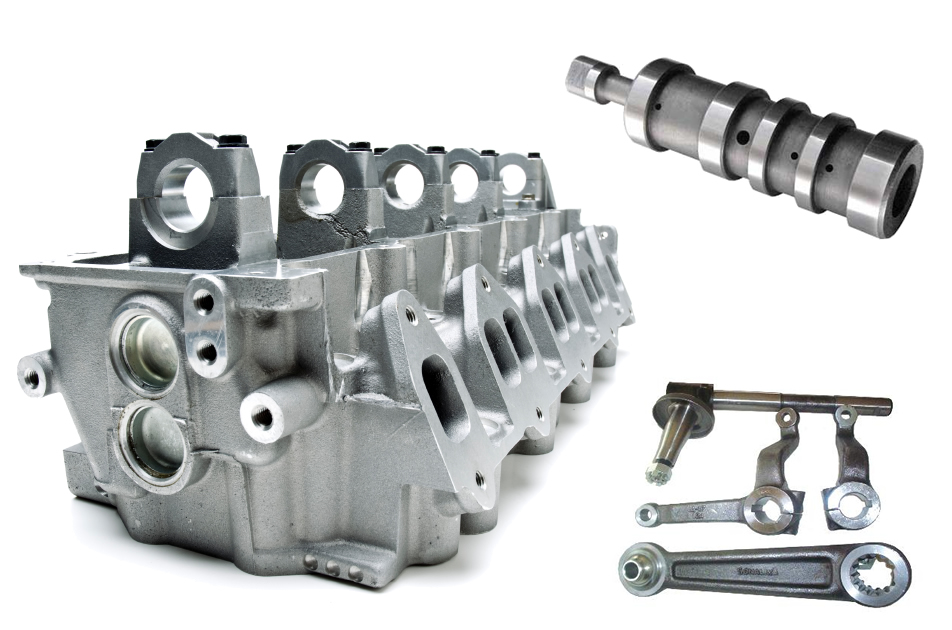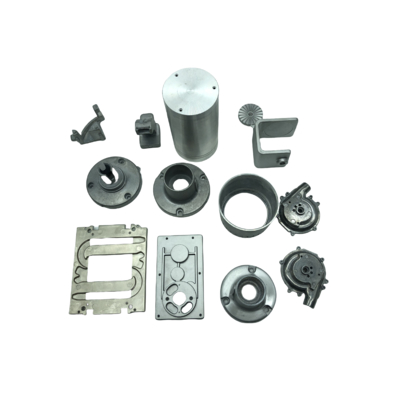How aluminum casting plays a major role in today’s manufacturing industry
Recognizing the Ecological Benefits of Light Weight Aluminum Foundry Techniques
Aluminum factory methods play a necessary duty ahead of time sustainability within the manufacturing sector. By carrying out innovative recycling techniques and energy-efficient methods, these methods greatly reduce waste and carbon footprints. Ingenious spreading techniques better improve source preservation efforts. As industries increasingly focus on ecological obligation, understanding the full effect of these practices ends up being crucial. What certain advancements are leading the way in this improvement?
The Role of Light Weight Aluminum in Lasting Manufacturing
Numerous products add to sustainable production, light weight aluminum stands out due to its one-of-a-kind residential properties and recyclability. This light-weight steel is not just durable but likewise has outstanding corrosion resistance, making it an excellent selection for various applications, from automotive to building and construction. Its high strength-to-weight proportion leads to power savings during transport and usage. In addition, light weight aluminum can be recycled forever without shedding its integral high qualities, advertising a circular economy.
The production process of aluminum has progressed, including energy-efficient approaches that minimize carbon impacts. By utilizing renewable resource sources, makers are progressively decreasing the environmental effect related to aluminum production. Additionally, using recycled aluminum calls for considerably much less energy contrasted to drawing out and fine-tuning primary light weight aluminum, resulting in lower greenhouse gas exhausts. As markets look for lasting options, light weight aluminum's convenience and green qualities setting it as a pivotal material in the search of greener manufacturing techniques.
Advanced Recycling Techniques in Aluminum Foundries
Advanced reusing strategies in light weight aluminum shops are changing the method scrap light weight aluminum is processed and reused. Ingenious approaches, such as closed-loop recycling systems, enable foundries to redeem light weight aluminum from production waste and outdated products efficiently. These systems decrease worldly loss and improve the high quality of recycled light weight aluminum, making it a practical alternative to key aluminum manufacturing.
Furthermore, advanced arranging modern technologies, including automated optical sorting and X-ray fluorescence, improve the splitting up of aluminum from other products, making sure higher pureness levels in recycled outputs. This precision decreases contamination, which can jeopardize the stability of the last product.
Additionally, the combination of innovative melting modern technologies, such as induction melting and energy-efficient heaters, streamlines the recycling procedure, lowering power usage. Jointly, these advancements add to an extra lasting light weight aluminum market by reducing reliance on virgin materials and lowering greenhouse gas emissions related to aluminum manufacturing.
Energy Efficiency Improvements in Shop Procedures
Power performance enhancements in aluminum factory procedures can significantly enhance sustainability techniques. Executing waste warm healing systems permits foundries to repurpose excess power, decreasing general energy consumption. In addition, improvements in procedure automation simplify operations, bring about reduced waste and enhanced source use.
Waste Heat Healing
Implementing waste warm healing systems in light weight aluminum factories substantially enhances energy efficiency by catching and recycling excess thermal energy created throughout production processes. These systems promote the conversion of lost warmth right into usable energy, which can be made use of for different applications within the factory, such as powering or pre-heating products devices. By recuperating warm that would otherwise be eliminated right into the atmosphere, shops can noticeably decrease their general power consumption and greenhouse gas discharges. This strategy not only reduces functional costs yet also promotes sustainable techniques within the market. Furthermore, the fostering of waste warm healing modern technologies lines up with regulative criteria aimed at reducing environmental effect, making it a vital element of modern aluminum foundry operations.
Process Automation Conveniences
Automating procedures in aluminum foundries can substantially boost power effectiveness by enhancing manufacturing process and lowering waste. By carrying out advanced innovations such as robotics and equipment learning, shops can improve operations, decreasing unneeded energy consumption. Automated systems facilitate specific control over temperature level and material handling, making certain that energy is made use of just when needed. Additionally, real-time surveillance permits instant modifications, decreasing the danger of energy loss. The combination of automation not just boosts productivity however additionally lowers functional costs, making foundries a lot more affordable. Therefore, these energy-efficient methods add considerably to sustainability goals, lowering the ecological impact of aluminum production while meeting increasing market needs - aluminum casting. Boosted energy effectiveness with automation represents a crucial step towards greener shop operations
Decreasing Waste Through Innovative Casting Techniques
Ingenious casting methods play a crucial function in reducing waste in aluminum shops. Methods such as advanced molding and the application of recyclable products considerably reduce manufacturing scrap. These techniques not only enhance efficiency but also add to a much more sustainable production process.
Advanced Molding Techniques
As sectors increasingly focus on sustainability, progressed molding methods in light weight aluminum foundries become reliable options for minimizing waste. These ingenious approaches, such as 3D printing and precision mold production, considerably boost the effectiveness of the casting process. By using computer-aided design (CAD) and simulation modern technologies, makers can optimize mold geometry, minimizing product usage while keeping product stability. In addition, progressed methods enable the production of complicated shapes that conventional methods can not achieve, decreasing the need for added machining and consequently decreasing scrap product. The adaptability of these methods permits fast prototyping, further decreasing lead times and power consumption. In general, the execution of advanced molding methods stands for an important step towards eco accountable aluminum production, lining up with worldwide sustainability goals.
Recyclable Material Utilization
Recyclable materials play a critical duty in decreasing waste within aluminum factories, transforming the spreading landscape via their effective application. By incorporating scrap light weight aluminum and various other recyclable components into the production procedure, foundries can greatly decrease the need for virgin products. This not only saves natural resources but likewise reduces energy consumption associated with mining and refining. Ingenious casting approaches, such as die casting and sand casting, allow for smooth integration of these materials, ensuring high-quality results. The usage of recyclable materials promotes a circular economic situation, click here where sources are continuously recycled and repurposed, lowering garbage dump payments. Ultimately, the tactical use recyclables boosts sustainability while advertising cost-effectiveness in light weight aluminum shop operations.
Lessening Manufacturing Scrap

Life Process Assessment of Light Weight Aluminum Products
Aluminum is commonly acknowledged for its resilient and lightweight properties, a thorough Life Cycle Assessment (LCA) discloses the ecological influences connected with its manufacturing, disposal, and usage. The LCA process takes a look at the power consumption, greenhouse gas emissions, and resource exhaustion connected to light weight aluminum items from extraction of bauxite ore to end-of-life monitoring. Primary aluminum production is energy-intensive, typically counting on nonrenewable fuel sources, which contributes significantly to carbon impacts. On the other hand, reusing aluminum offers considerable environmental benefits, as it utilizes only a fraction of the power needed for primary manufacturing. The reusing process minimizes landfill waste and saves all-natural sources. The LCA likewise considers the item's durability and possibility for reuse, emphasizing the value of lasting design. Generally, comprehending the life process effects of aluminum items is vital for making educated decisions that focus on environmental sustainability within the market.
Case Studies: Effective Sustainable Practices in the Sector
The aluminum sector has actually started to welcome ingenious sustainable methods that attend to the environmental challenges identified in Life process Assessments. One noteworthy case is a leading factory that implemented a closed-loop recycling system, considerably lowering waste and energy intake. By reusing scrap aluminum in manufacturing, the facility attained a 40% reduction in its carbon impact.
One more instance includes a manufacturer that took on renewable resource resources, powering its operations with solar and wind power - aluminum casting. This shift not just reduced greenhouse gas emissions however additionally improved the company's credibility among ecologically aware consumers
Furthermore, a third shop has bought innovative spreading methods, which enhance material usage and minimize issues, further reducing resource intake. These study show that the light weight aluminum sector is qualified of integrating sustainable practices, demonstrating both environmental duty and economic viability, eventually contributing to a more sustainable future.
Often Asked Concerns
Just How Does Aluminum Contrast to Various Other Steels in Sustainability?
Aluminum is typically taken into consideration more lasting than many metals due to its recyclability, lower energy demands for production, and minimized ecological effect. Its lifecycle performance exceeds that of steel and copper in different applications.
What Is the Carbon Impact of Light Weight Aluminum Shop Processes?
The carbon impact of light weight aluminum foundry processes varies, usually ranging from 4 to 15 metric lots of CO2 per heap of light weight aluminum produced. Elements influencing this include energy resources, technology, and the efficiency of operations.
Are There Health And Wellness Risks Related To Aluminum Shop Procedures?

What Are the Prices Connected With Lasting Aluminum Techniques?
The costs related to sustainable light weight aluminum techniques consist of greater preliminary financial investments in technology, potential rises in operational costs, and continuous upkeep. Nevertheless, these are typically countered by long-lasting financial savings and reduced ecological impact.
How Does Light Weight Aluminum Recycling Impact Resident Communities?
Aluminum recycling positively impacts regional communities by creating jobs, reducing garbage dump waste, and lowering energy prices. It fosters economic growth and advertises environmental stewardship, leading to healthier living problems and enhanced neighborhood involvement in sustainability campaigns.
In addition, the usage of recycled aluminum calls for considerably much less power contrasted to extracting and improving key light weight aluminum, leading to lower greenhouse gas emissions. Advanced reusing strategies in aluminum foundries are reinventing the way scrap light weight aluminum is processed and reused. Aluminum Foundry. Carrying out waste warmth recovery systems in light weight aluminum factories considerably improves energy efficiency by recording and reusing excess thermal power produced during production processes. Automating procedures in light weight aluminum factories can considerably boost energy performance by enhancing production process and reducing waste. The carbon impact of aluminum foundry processes differs, usually ranging from 4 to 15 statistics lots of CO2 per bunch of aluminum generated